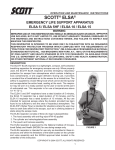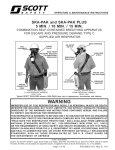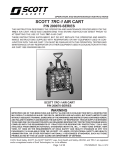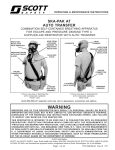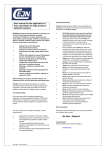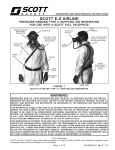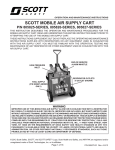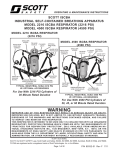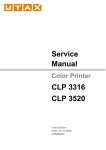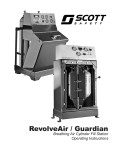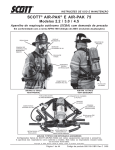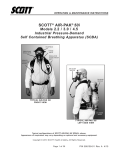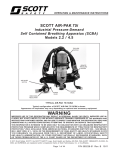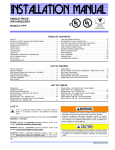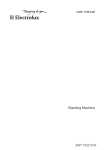Download SCOTT® CARRI-AIR™ PORTABLE AIR SUPPLY
Transcript
OPERATION AND MAINTENANCE INSTRUCTIONS SCOTT® CARRI-AIR™ PORTABLE AIR SUPPLY WITH BELL ALARM FOR USE WITH A SCOTT 4500 PSI AIR CYLINDER TO SUPPLY BREATHING AIR TO SCOTT AIR-PAK®, SKA-PAK®, SKA-PAK PLUS, OR E-Z AIRLINETM This instruction sheet describes the operation and maintenance instructions for the SCOTT CARRI-AIR with Bell Alarm portable air supply. Read and understand this entire instruction sheet before attempting the use of the SCOTT CARRI-AIR with Bell Alarm portable air supply. INTRODUCTION SCOTT CARRI-AIR with Bell Alarm portable air supply is intended to supply air to a respirator being used by a single person only and must be used only with a complete SCOTT AIR-PAK with duration extending accessory, Ska-Pak, Ska-Pak Plus, or E-Z AIRLINE respirator. The SCOTT CARRI-AIR with Bell Alarm portable air supply consists of a pressure reducer with Bell Alarm to connect to a SCOTT cylinder and valve assembly, a quick disconnect socket for connection to an air supply hose, a cylinder stand, and a cylinder retention assembly with carrying handle for securing the compressed air cylinder (see FIGURE 1). The SCOTT CARRI-AIR with Bell Alarm portable air supply is designed to fit only 45 minute or 60 minute 4500 psi SCOTT cylinders. The Bell Alarm end of service time indicator will actuate when the cylinder pressure drops to approximately 750 psi. THIS PORTABLE AIR SUPPLY DOES NOT OPERATE THE VIBRALERT® OR ANY OTHER END OF SERVICE TIME INDICATOR ALARMS ON AN ATTACHED AIR-PAK WITH DURATION EXTENDING ACCESSORY RESPIRATOR. The air supply hose connecting the respirator to the CARRI-AIR with Bell Alarm Portable air supply must be the hose approved for use with the respirator and the coupling must match the outlet coupling on the CARRI-AIR with Bell Alarm portable air supply. QUICK DISCONNECT FITTING REDUCER ASSEMBLY WITH BELL ALARM CYLINDER RETENTION ASSEMBLY CYLINDER STAND CARRYING HANDLE REDUCER COUPLING TRI-SLIDE BUCKLE HANDLE BRACKET TOGGLE LATCH FIGURE 1 (Note: Air Cylinder Shown for Illustration Only) WARNING THE SCOTT CARRI-AIR WITH BELL ALARM PORTABLE AIR SUPPLY MAY BE USED TO SUPPORT HUMAN LIFE IN A HAZARDOUS ATMOSPHERE. IMPROPER USE OF THIS BREATHING AIR SUPPLY MAY RESULT IN SERIOUS INJURY OR DEATH. IMPROPER USE INCLUDES, BUT IS NOT LIMITED TO, USE WITHOUT ADEQUATE TRAINING, DISREGARD OF THE WARNINGS AND INSTRUCTIONS CONTAINED HEREIN, AND FAILURE TO INSPECT AND MAINTAIN THE AIR SUPPLY AND/OR THE RESPIRATOR USED WITH IT. THIS AIR SUPPLY IS INTENDED TO BE USED ONLY IN CONJUNCTION WITH AN ORGANIZED RESPIRATORY PROTECTION PROGRAM WHICH COMPLIES WITH THE REQUIREMENTS OF “PRACTICES FOR RESPIRATORY PROTECTION,” Z.88.2 AVAILABLE FROM AMERICAN NATIONAL STANDARDS INSTITUTE INC., 11 WEST 42ND STREET, NEW YORK, N.Y. 10036 OR THE REQUIREMENTS OF OSHA SAFETY AND HEALTH STANDARD 29 CFR 1910 PARAGRAPH 134 AVAILABLE FROM THE U.S. DEPT. OF LABOR, OCCUPATIONAL SAFETY AND HEALTH ADMINISTRATION, OR OTHER PERTINENT NATIONALLY R E C O G N I Z E D S TA N D A R D S , S U C H A S T H O S E P R O M U L G AT E D B Y T H E U S C O A S T G U A R D O R D E PA R T M E N T O F D E F E N S E . 1 SERVICE LIFE The SCOTT CARRI-AIR with Bell Alarm portable air supply is intended to accommodate either a 45 minute or 60 minute duration cylinder. It is to be used and maintained only by trained personnel. This CARRI-AIR with Bell Alarm portable air supply is equipped with an end-of-service indicator alarm. However, if the respirator user cannot carry the unit to the immediate area where it is to be used, it is essential that a trained person other than the respirator user, outside the hazardous atmosphere, monitor the volume of air in the CARRIAIR with Bell Alarm portable air supply cylinder and warn the respirator user of diminishing air supply in sufficient time for the user to exit the hazardous atmosphere. The person monitoring the cylinder pressure gauge must have an effective method of communication with the respirator user. Effective communication must assure that the respirator user will be notified when to leave the area requiring respiratory protection and may include, but is not limited to, unassisted verbal communication, radio communication, wired communication or a prearranged signal such as an air horn or other means of signalling. THIS CARRI-AIR WITH BELL ALARM PORTABLE AIR SUPPLY WILL NOT OPERATE THE VIBRALERT ALARM IN A SCOTT FACEPIECE MOUNTED REGULATOR. ONLY THE BELL ALARM WILL OPERATE WHEN THE CYLINDER PRESSURE DROPS TO THE WARNING LEVEL. THE VIBRALERT ALARM WILL OPERATE NORMALLY WHEN THE USER IS BREATHING FROM THE AIR-PAK RESPIRATOR AIR SUPPLY CYLINDER. The user should not expect to obtain exactly the cylinder rated duration from this air supply on each use. The work being performed may be more or less strenuous than that used in the National Institute of Occupational Safety and Health (NIOSH) respirator testing. Where work is more strenuous, the duration may be shorter, possibly as short as one-half the nominal service time or less. Always verify that the CARRI-AIR with Bell Alarm portable air supply cylinder is fully charged before entering the hazardous atmosphere. The duration of use of the respirator supplied by the CARRI-AIR with Bell Alarm portable air supply will depend on such factors as: 1. the capacity of the cylinder installed, 2. the degree of physical activity of the user; 3. the physical condition of the user; 4. the degree to which the user’s breathing is affected by excitement, fear or other emotional factors; 5. the degree of training or experience which the user has with this or similar equipment; 6. whether or not the cylinder is fully charged at the start of the work period; 7. the possible presence in the compressed air of carbon dioxide concentrations greater than .04% normally found in atmospheric air; 8. the atmospheric pressure; for example, if used in a pressurized tunnel or caisson at 2 atmospheres (15 psi gauge) the duration will be one-half as long as when used at 1 atmosphere; and at 3 atmospheres will be one-third as long; 9. loose or improperly fitting facepiece; 10. the condition of the respirator being used. WARNING FAILURE OF THE RESPIRATOR USER TO MONITOR THE AIR GAUGE OF THE CARRI-AIR WITH BELL ALARM CYLINDER AND/OR FAILURE OF THE RESPIRATOR USER TO RESPOND TO THE BELL ALARM WHEN IT ACTUATES MAY RESULT IN SUDDEN AND UNEXPECTED TERMINATION OF THE AIR SUPPLY TO THE RESPIRATOR USER WHICH COULD RESULT IN SERIOUS INJURY OR DEATH. WARNING FAILURE TO ASSIGN A TRAINED PERSON TO MONITOR THE AIR GAUGE OF THE CARRI-AIR WITH BELL ALARM CYLINDER AND/OR FAILURE TO MAINTAIN EFFECTIVE COMMUNICATIONS WITH THE RESPIRATOR USER SUPPLIED BY THE CARRI-AIR WITH BELL ALARM PORTABLE AIR SUPPLY MAY RESULT IN SUDDEN AND UNEXPECTED TERMINATION OF THE AIR SUPPLY TO THE RESPIRATOR USER WHICH COULD RESULT IN SERIOUS INJURY OR DEATH. WARNING IF THIS CARRI-AIR PORTABLE AIR SUPPLY IS USED WITH A SCOTT FACEPIECE MOUNTED REGULATOR EQUIPPED WITH A VIBRALERT ALARM, THE VIBRALERT ALARM WILL NOT OPERATE. ONLY THE BELL ALARM WILL OPERATE WHEN THE CYLINDER PRESSURE DROPS TO THE WARNING LEVEL. FAILURE TO UNDERSTAND THE OPERATION OF THIS PORTABLE AIR SUPPLY WHEN USED WITH OTHER EQUIPMENT MAY RESULT IN CIRCUMSTANCES THAT COULD CAUSE SERIOUS INJURY OR DEATH. WARNING ALWAYS VERIFY THAT THE AIR SUPPLY CYLINDER IS FULLY CHARGED BEFORE ENTRY INTO ANY HAZARDOUS ATMOSPHERE. USE OF A PARTIAL CYLINDER MAY RESULT IN SUDDEN AND UNEXPECTED TERMINATION OF THE AIR SUPPLY TO THE RESPIRATOR USER WHICH COULD RESULT IN SERIOUS INJURY OR DEATH. WARNING SCOTT E-Z AIRLINE RESPIRATORS MAY NOT BE USED FOR RESPIRATORY PROTECTION IN ATMOSPHERES WHICH ARE, OR MAY BECOME, IMMEDIATELY DANGEROUS TO LIFE OR HEALTH OR ATMOSPHERES IN WHICH THE CONTAMINANT(S) OR CONCENTRATIONS OF THE CONTAMINANT(S) IS UNKNOWN. SEE THE INSTRUCTIONS SUPPLIED WITH THE RESPIRATOR BEING USED FOR ADDITIONAL INFORMATION AND ADDITIONAL WARNINGS. 2 REGULAR OPERATIONAL INSPECTION The following procedure shall be used when you first receive the CARRI-AIR with Bell Alarm portable air supply and for inspection before each use. If any malfunction is noted, remove the CARRI-AIR with Bell Alarm portable air supply from service and tag for repair by authorized personnel. 1. Visually inspect the SCOTT CARRI-AIR with Bell Alarm portable air supply for worn or damaged components. Check to make sure that cylinder retention strap is not abraded around area of carrying handle bracket and that cylinder retention assembly is secured. 2. Check the latest cylinder hydrostatic test date to ensure it is current. All cylinders used with Scott CARRI-AIR with Bell Alarm must be visually inspected regularly and hydrostatically tested by a licensed cylinder retester in accordance with the appropriate US Department of Transportation (DOT) specification or the applicable DOT exemption. For a complete listing of retest date requirements, refer to the current revision of Safety Precautions for Air-Pak Cylinders , Scott P/N 89080-01, available on request from Scott Health and Safety. Composite cylinders (those cylinders utilizing fiber over wrap) must be tested in accordance with the DOT exemption status up to the maximum life of fiber overwrapped cylinders which, at the time of the publication of this instruction, is 15 years from the date of manufacture. The date of manufacture marked on the cylinder is also the date of the first hydrostatic test. It is the responsibility of your organized respiratory protection program to arrange for visual inspection and hydrostatic testing of cylinders by a licensed retester. 3. Visually inspect cylinder and valve assembly for physical damage such as dents or gouges in metal or in composite wrapping. Cylinders which show physical damage or exposure to high heat or flame, such as paint turned brown or black, decals charred or missing, pressure gauge lens melted or elastomeric bumper distorted, and cylinders which show evidence of exposure to chemicals such as discoloration, cracks in the cylinder or the composite wrapping, peeling of the outer layers of the composite wrapping and/or bulging of the cylinder wall, shall be removed from service and emptied of compressed air. Refer to current applicable publications on compressed gas cylinder inspection available from Compressed Gas Association Inc., 1725 Jefferson Davis Hwy., Suite 1004, Arlington, VA 22202, (703-412-0900) for a detailed explanation of cylinder inspection procedures. 4. Check cylinder pressure gauge for “FULL” indication. If cylinder pressure is less than “FULL,” replace with a fully charged cylinder. Use only SCOTT 4500 psi cylinders with an air supply rated at 45 minutes or 60 minutes. 5. Check to ensure reducer coupling is hand tightened to the cylinder valve outlet. Wrenches shall not be used as damage to the coupling gasket may result. 6. ATTACH AN AIR SUPPLY LINE TO THE FEMALE QUICK DISCONNECT COUPLING ON THE REDUCER. Check that the quick disconnect engages properly. Test for proper engagement by tugging on the coupling. See AIR LINE CONNECTION section of this instruction for details of operation of specific quick disconnects. 7. To test the Bell Alarm, open the cylinder valve fully. The Bell Alarm shall ring one or more times. Close the cylinder valve. Bleed off the residual air in the reducer by inserting an open male quick disconnect into the female coupling on the reducer. The Bell Alarm shall ring several times until all the air has been bled from the reducer. 3 WARNING FOLLOW THE REGULAR OPERATIONAL INSPECTION PROCEDURE EXACTLY. IF THE BELL ALARM END OF SERVICE INDICATOR DOES NOT ACTUATE AS DESCRIBED IN THIS INSTRUCTION, OR ANY OTHER OPERATIONAL MALFUNCTION IS NOTED, DO NOT USE THE PORTABLE AIR SUPPLY. REMOVE THE PORTABLE AIR SUPPLY FROM SERVICE AND TAG IT FOR REPAIR BY AUTHORIZED PERSONNEL. FAILURE TO PROPERLY IDENTIFY MALF U N C T I O N S M AY R E S U LT I N S E R I O U S INJURY OR DEATH. WARNING DAMAGED CYLINDERS MAY SUDDENLY LEAK OR RUPTURE IF LEFT CHARGED W I T H C O M P R E S S E D A I R . FA I L U R E T O INSPECT FOR DAMAGE AND TO EMPTY THE AIR FROM DAMAGED CYLINDERS MAY RESULT FAILURE OF THE CYLINDER WHICH COULD CAUSE SERIOUS INJURY OR DEATH. PREPARATION FOR USE AIR CYLINDER INSTALLATION 1. Place the CARRI-AIR with Bell Alarm cylinder stand on a flat surface with the handle and cylinder retention assembly on top. 2. The SCOTT CARRI-AIR with Bell Alarm portable air supply is designed to fit only 45 minute or 60 minute 4500 psi SCOTT air cylinders. The SCOTT CARRI-AIR with Bell Alarm portable air supply includes a locking tab on the cylinder stand, which engages with a bracket at the neck of the cylinder and a cylinder retention band, which engages the diameter of the cylinder body. Cylinders without a bracket or with a diameter different than the SCOTT 45 minute and 60 minute rated 4500 psi cylinders will not be properly retained in the CARRI-AIR with Bell Alarm portable air supply. 3. Slide the cylinder underneath the cylinder retention assembly with the cylinder hanger bracket pointed down. See FIGURE 2. FIGURE 2 FIGURE 3 4. Engage the cylinder hanger bracket in the locking tab on the cylinder stand. See FIGURE 3. 5. Center the carrying handle and handle bracket over the top of the cylinder. Secure the cylinder in place with the retention strap by pushing the toggle lever toward the stand frame. See FIGURE 4. FIGURE 4 FIGURE 5 6. Lock the toggle lever by attaching the cylinder latch toggle strap to the snap on the toggle lever. See FIGURE 5. 4 WARNING DO NOT USE AIR CYLINDERS OTHER THAN SCOTT 45 MINUTE OR 60 MINUTE 4500 PSI CYLINDERS. USE OF OTHER SIZE CYLINDERS MAY RESULT IN IMPROPER RETENTION OF THE CYLINDER IN THE CARRI-AIR WITH BELL ALARM STAND AND POSSIBLE DAMAGE TO THE HIGH PRESSURE AIR CYLINDER WHICH MAY RESULT IN SERIOUS INJURY OR DEATH. 7. Ensure that the cylinder is securely held in place on the cylinder stand by the cylinder retention assembly. Do not force the toggle lever to lock. FIGURE 6 If the retention strap is too tight, use the tri-slide buckle to increase the retention strap engagement length, then re-attempt to engage the latch assembly. See FIGURE 6. If the retention strap is too loose, disengage the toggle lever, decrease the retention strap engagement length using the tri-slide buckle and engage the latch assembly again. See FIGURE 6. CAUTION THE USE OF FORCE TO LOCK THE TOGGLE LEVER MAY RESULT IN DAMAGE TO THE CYLINDER RETENTION ASSEMBLY. ATTACHING THE REDUCER ASSEMBLY 1. Check to ensure the reducer coupling is clean and free from dirt. 2. Check to ensure the coupling gasket is not damaged. See FIGURE 7. COUPLING GASKET REDUCER COUPLING CYLINDER VALVE OUTLET FIGURE 7 FIGURE 8 3. Check to ensure the cylinder valve outlet is clean and free from dirt. See FIGURE 8. 4. Thread the reducer coupling onto the cylinder valve. The reducer coupling must be hand tightened to the cylinder valve outlet. Wrenches shall not be used as damage to the coupling gasket may result. WARNING VERIFY THE ENGAGEMENT OF THE COUPLING AS DESCRIBED. FAILURE TO ENSURE ENGAGEMENT OF THE COUPLING MAY LEAD TO HOSE SEPARATION AND LOSS OF BREATHING AIR WHICH COULD LEAD TO SERIOUS INJURY OR DEATH. CAUTION WRENCHES SHALL NOT BE USED, AS DAMAGE, PARTICULARLY TO THE COUPLING GASKET, MAY RESULT. 5 AIR LINE CONNECTION Verify that the SCOTT CARRI-AIR with Bell Alarm portable air supply unit you have has the correct quick disconnect to match your system. There are 5 reducer assembly styles available to match your SCOTT supply hose: – P/N 804911-05 (with Hansen† quick disconnect fitting), – P/N 804911-06 (with Schrader† quick disconnect fitting), – P/N 804911-07 (with Hansen† HK quick disconnect fitting) – P/N 804911-08 (with Foster† quick disconnect fitting) – P/N 804911-09 (with Cejn† quick disconnect fitting) Use FIGURE 9 to identify the fitting on your SCOTT supply hose and to verify the matching reducer assembly on the CARRI-AIR with Bell Alarm portable air supply. See TABLE 2 of this instruction for information on operation of the different quick disconnect fittings and allowable lengths and maximum number of hose segments. Use TABLE 1 for a list of part numbers for hose assemblies made with the available brands of quick disconnect couplings. TABLE 1 IDENTIFICATION OF SUPPLY HOSES Quick Disconnect Coupling used on air supply hose Corresponding SCOTT Supply Hose Series 1 Hansen 3000 Series or Foster 3 Series Manual 30010 series or 26370 series Schrader Standard Twist Lock 30020 series Hansen 2HK Series 26369 series Cejn 342 Series 805659 series NOTE: 1 Scott Part Number stamped into hose within 6 inches of either end. † Hansen is a registered trademark of Tuthill Corporation. † Foster is a registered trademark of Foster Manufacturing Co., Inc. † Schrader is a registered trademark of Scovill, Inc. † Cejn is a registered trademark of Cejn AB 6 WARNING SUPPLY HOSES FOR THE CARRI-AIR WITH BELL ALARM PORTABLE AIR SUPPLY MUST NOT EXCEED THE MAXIMUM ALLOWABLE LENGTH AS SPECIFIED IN THE OPERATIONS AND MAINTENANCE INSTRUCTIONS OF THE ASSOCIATED SCOTT RESPIRATOR PRODUCT. SPECIFIC RESTRICTIONS ON HOSE LENGTH AND MAXIMUM NUMBER OF SEGMENTS OF HOSE APPLY TO SPECIFIC SUPPLY HOSE TYPES. SEE THE INSTRUCTIONS SUPPLIED WITH THE RESPIRATOR BEING USED FOR ADDITIONAL INFORMATION AND WARNINGS. FAILURE TO OBSERVE NECESSARY WARNINGS AND INSTRUCTIONS FOR USE OF SUPPLY HOSES MAY CAUSE A FAILURE OF THE EQUIPMENT WHICH COULD RESULT IN SERIOUS INJURY OR DEATH. WARNING THE USER OF THIS RESPIRATOR MAY HAVE TO DISCONNECT THE HOSE COUPLING SUDDENLY AND UNDER STRESSFUL CONDITIONS. THE USER MUST BE ABLE TO DISCONNECT THE COUPLING UNDER THE CONDITIONS WHICH MAY BE ENCOUNTERED DURING USE, FOR EXAMPLE, WITHOUT BEING ABLE TO SEE THE COUPLING, WITH GLOVES ON, WITH ONE HAND, ETC. FAILURE OF THE USER TO ADEQUATELY PERFORM THESE TASKS UNDER STRESSFUL CONDITIONS MAY RESULT IN SERIOUS INJURY OR DEATH. TABLE 2 LIMITATIONS AND OPERATING INSTRUCTIONS FOR SUPPLY HOSE NOTE: THE AIR SUPPLY PRESSURE MUST BE MAINTAINED BETWEEN 60 PSIG AND 125 PSIG WHILE FLOWING AT LEAST 200 LITERS PER MINUTE (LPM) TO EACH USER. Supply Hose1 26369 Series with stainless steel Hansen HK couplings 26370 Series with stainless steel Foster couplings 30010 Series with brass Hansen couplings 30020 Series with steel Schrader couplings 805659 Series with brass CEJN couplings 1 2 3 Approved Total Lengths (ft)2 Maximum Number of Segments Approved 0 to 150 63 0 to 300 123 0 to 300 123 0 to 300 Note: The user shall practice and be able to disconnect the couplings quickly in an emergency situation. 1. To connect the coupling, rotate socket sleeve "B" until the alignment notch in the sleeve is in line with alignment peg in body "A". 2. Slide sleeve "B" toward the supply hose (away from plug "C") and insert plug "C" into socket "A". Release sleeve "B" while pushing the plug into the socket until engaged, as evidenced by a "click". Test for positive engagement by tugging on the plug. 3. Rotate sleeve "B" one-quarter to one-half turn to lock the plug against accidental release. 4. To disconnect the coupling, realign sleeve "B" with the body of socket "A" as described in step 1. Slide sleeve "B" away from the body (toward the supply hose) to release the plug fitting from the socket. IF IT IS NOT PRACTICAL TO SEE THE ALIGNMENT NOTCH IN THE SLEEVE, USE THE FOLLOWING PROCEDURE TO DISCONNECT THE COUPLING: 1. Grasp sleeve "B" with the right hand. 2. Simultaneously rotate and push the sleeve away from the plug until the alignment notch in the sleeve lines up with the alignment peg in the body and the socket separates from the plug. 1. Insert plug fitting "C" into socket "A" and continue pushing until it is engaged as evidenced by a "click". 2. Test for positive engagement by tugging on the plug. 3. Disconnect the coupling by rotating sleeve "B" 1/8 turn in the clockwise direction as viewed from the female end of socket "A". 123 1. Insert plug fitting "C" into socket "A" and continue pushing until it is engaged as evidenced by a "click". 2. Test for positive engagement by tugging on the plug. 3. Disconnect the coupling by pushing in on plug "C" while pulling back on sleeve "B". Plug "C" will separate. 123 0 to 300 INSTRUCTIONS FOR OPERATION OF COUPLINGS The female connectors on all supply hose series are checked to stop the flow of air when they are disconnected. Both male and female connectors are checked on 26369 series supply hose. "0" feet = direct connection to air supply source. Segments of supply hose are commonly available in 25 ft, 50 ft, 75 ft, and 100 ft length segments. A B C HANSEN HK COUPLING USED ON 26369 SERIES A B C FOSTER COUPLING USED ON 26370 SERIES A B C A B C A B C SCHRADER COUPLING HANSEN COUPLING USED CEJN COUPLING USED USED ON 30020 ON 30010 SERIES ON 805659 SERIES SERIES FIGURE 9 COUPLINGS USED ON SUPPLY HOSES 7 WARNING THE INFORMATION BELOW IS MEANT TO SUPPLEMENT, NOT REPLACE, THE INSTRUCTIONS, TRAINING, SUPERVISION, MAINTENANCE, AND OTHER ELEMENTS OF YOUR ORGANIZED RESPIRATORY PROTECTION PROGRAM. SEE WARNING ON FIRST PAGE OF THIS DOCUMENT. FAILURE TO HEED ANY WARNINGS IN THIS INSTRUCTION MAY RESULT IN SERIOUS INJURY OR DEATH. USE OF CARRI-AIR WITH BELL ALARM PORTABLE AIR SUPPLY WARNING Use only in accordance with your respiratory protection program. The SCOTT CARRI-AIR with Bell Alarm portable air supply may only be taken into an area requiring respiratory protection if used with a SCOTT AIR-PAK WITH DURATION EXTENDING ACCESSORY, SKA-PAK, or SKA-PAK PLUS respirator. If the SCOTT CARRI-AIR with Bell Alarm must be positioned some distance from the respirator user or is used with a SCOTT E-Z AIRLINE respirator, it must be placed in a safe area as described by your organized respiratory program and monitored by someone while the user enters the area requiring respiratory protection. Perform REGULAR OPERATIONAL INSPECTION procedure of the CARRI-AIR with Bell Alarm portable air supply as outlined in this manual. SCOTT E-Z AIRLINE RESPIRATORS MAY NOT BE USED FOR RESPIRATORY PROTECTION IN ATMOSPHERES WHICH ARE, OR MAY BECOME, IMMEDIATELY DANGEROUS TO LIFE OR HEALTH OR ATMOSPHERES IN WHICH THE CONTAMINANT(S) OR CONCENTRATIONS OF THE CONTAMINANT(S) IS UNKNOWN. SEE THE INSTRUCTIONS SUPPLIED WITH THE RESPIRATOR BEING USED FOR ADDITIONAL INFORMATION AND ADDITIONAL WARNINGS. WARNING USE WITH AIR SUPPLY OUTSIDE AREA REQUIRING RESPIRATORY PROTECTION 1. Locate a site outside of area requiring respiratory protection to position the CARRI-AIR with Bell Alarm portable air supply as prescribed in your respiratory protection program. 2. Ensure that CARRI-AIR with Bell Alarm portable air supply is secured on a flat, level surface where the unit or cylinder will not shift or slide. Arrange the air hose in a manner which will prevent a sudden or unexpected pull on the air hose from moving or damaging the CARRI-AIR with Bell Alarm portable air supply. 3. Assign a trained person other than the respirator user to monitor the air gauge on the air supply cylinder. The person monitoring the air gauge must be instructed to notify the respirator user in the hazardous area when the air pressure has been reduced to a predetermined value or when the Bell Alarm sounds, whichever comes first. The Bell Alarm will actuate when the cylinder pressure drops to approximately 750 psi, but the respirator user must plan on switching to the air supply from the AIR-PAK WITH DURATION EXTENDING ACCESSORY, SKA-PAK, or SKA-PAK PLUS, or exiting the hazardous area if used with a SCOTT E-Z AIRLINE respirator at the predetermined value regardless of whether the Bell Alarm has actuated or not. 4. Be certain the person assigned to monitor the pressure gauge of the air supply cylinder has an effective means of communicating with or notifying the respirator user. See the SERVICE LIFE section on page two of this instruction. 5. Connect the air supply hose of a suitable length to the accessory hose on a SCOTT AIR-PAK WITH DURATION EXTENDING ACCESSORY, SKA-PAK, or SKA-PAK PLUS, or to the E-Z AIRLINE respirator and to the CARRI-AIR with Bell Alarm portable air supply. Be certain that the air supply hose is of the type certified for use with the respirator being used and that the length and total number of segments of air hose complies with the instructions supplied with the respirator. See TABLE 2 of this instruction for additional information. Perform the Regular Operational Inspection of the respirator, prepare the respirator for use, and don the respirator in accordance with the instructions supplied with the respirator and the procedures of your organized respiratory program. 6. To begin use, fully open the air supply cylinder valve of the CARRI-AIR with Bell Alarm portable air supply, check facepiece fit as directed in the respirator instructions and proceed with respirator use in accordance with your organized respirator program. 8 IF THIS CARRI-AIR PORTABLE AIR SUPPLY IS USED WITH A SCOTT FACEPIECE MOUNTED REGULATOR EQUIPPED WITH A VIBRALERT ALARM, THE VIBRALERT ALARM WILL NOT OPERATE. ONLY THE BELL ALARM ON THE CARRI-AIR PORTABLE AIR SUPPLY WILL OPERATE WHEN THE CYLINDER PRESSURE DROPS TO THE WARNING LEVEL. FAILURE TO UNDERSTAND THE OPERATION OF THIS PORTABLE AIR SUPPLY WHEN USED WITH OTHER EQUIPMENT MAY RESULT IN SUDDEN AND UNEXPECTED TERMINATION OF THE AIR SUPPLY TO THE RESPIRATOR USER WHICH COULD RESULT IN SERIOUS INJURY OR DEATH. WARNING FAILURE TO ASSIGN A TRAINED PERSON TO MONITOR THE AIR GAUGE OF THE CYLINDER OF THE CARRI-AIR WITH BELL ALARM PORTABLE AIR SUPPLY AND/OR FAILURE TO MAINTAIN EFFECTIVE COMMUNICATIONS WITH THE RESPIRATOR USER PORTABLE AIR SUPPLY MAY RESULT IN SUDDEN AND UNEXPECTED TERMINATION OF THE AIR SUPPLY TO THE RESPIRATOR USER WHICH COULD CAUSE SERIOUS INJURY OR DEATH. WARNING THE CYLINDER VALVE MUST BE FULLY OPENED FOR PROPER OPERATION OF THE RESPIRATOR. FAILURE TO FULLY OPEN THE CYLINDER VALVE MAY RESULT IN REDUCED SUPPLY OF BREATHING AIR TO THE RESPIRATOR USER WHICH MAY CAUSE SERIOUS INJURY OR DEATH. 7. During use of the respirator, if the Bell Alarm actuates or if breathing becomes difficult, the air supply stops or any other difficulty is encountered before the Bell Alarm actuates, leave the area requiring respiratory protection immediately. When using an AIR-PAK WITH DURATION EXTENDING ACCESSORY, SKA-PAK, or SKA-PAK PLUS respirator, open the cylinder valve and disconnect from the air supply hose. Leave the area requiring respiratory protection immediately or within the duration of the air supply cylinder installed on the AIR-PAK WITH DURATION EXTENDING ACCESSORY, SKAPAK, or SKA-PAK PLUS respirator as prescribed by your organized respiratory protection program. 8. User must leave hazardous area or be certain that respiratory protection is no longer required. 9. Doff (remove) respirator facepiece as directed in the instructions of the respirator being used. 10. Push in and rotate cylinder valve knob clockwise to close cylinder valve on the CARRI-AIR with Bell Alarm portable air supply. Replace air cylinder with a fully charged air cylinder in preparation for next use (see REMOVAL OF SPENT AIR CYLINDER section of this instruction). Tag the depleted cylinders for service by authorized personnel. USE WITH AIR SUPPLY INSIDE AREA REQUIRING RESPIRATORY PROTECTION 1. Don the AIR-PAK WITH DURATION EXTENDING ACCESSORY, SKA-PAK, or SKA-PAK PLUS respirator in accordance with the Operation and Maintenance Instructions provided with the respirator. Do not use with a SCOTT EZ AIRLINE respirator when it is necessary to take the CARRI-AIR with Bell Alarm portable air supply into an area requiring respiratory protection. 2. Connect the air supply hose of a SCOTT AIR-PAK WITH DURATION EXTENDING ACCESSORY, SKA-PAK, or SKA-PAK PLUS respirator to the CARRI-AIR with Bell Alarm portable air supply. Be certain that the air supply hose is of the type certified for use with the respirator being used and that the length and total number of segments of air hose complies with the instructions supplied with the respirator. See TABLE 2 of this instruction for additional information. Following the instructions supplied with the respirator and the procedures of your organized respiratory program perform the Regular Operational Inspection of the respirator if required, prepare the respirator for use and don the respirator. 3. To begin use, fully open the air supply cylinder valve of the CARRI-AIR with Bell Alarm portable air supply, check facepiece fit as directed in the respirator instructions and proceed with respirator use in accordance with your organized respirator program. 4. When placing the CARRI-AIR with Bell Alarm portable air supply down in the work area, verify that it is secured on a flat, level surface where the unit or cylinder will not shift or slide. Arrange the air hose in a manner which will prevent a sudden or unexpected pull on the air hose from moving or damaging the CARRI-AIR with Bell Alarm portable air supply. 5. Always remain close enough to the CARRI-AIR with Bell Alarm portable air supply to be able to hear the end-of-service time indicator bell when it actuates. 6. Periodically check the air gauge on the cylinder to monitor the air pressure. See the SERVICE LIFE section on page two of this instruction. The Bell Alarm will actuate when the cylinder reaches approximately 750 psi, but the respirator user must plan on switching to the air supply from the AIR-PAK WITH DURATION EXTENDING ACCESSORY, SKA-PAK, or SKA-PAK PLUS respirator at this point regardless of whether the Bell Alarm has actuated or not. USE OF CARRI-AIR WITH BELL ALARM PORTABLE AIR SUPPLY CONTINUED ON NEXT PAGE... 9 WARNING THE CYLINDER VALVE MUST BE FULLY OPENED FOR PROPER OPERATION OF THE RESPIRATOR. FAILURE TO FULLY OPEN THE CYLINDER VALVE MAY RESULT IN REDUCED SUPPLY OF BREATHING AIR TO THE RESPIRATOR USER WHICH MAY CAUSE SERIOUS INJURY OR DEATH. USE OF CARRI-AIR WITH BELL ALARM PORTABLE AIR SUPPLY CONTINUED... 7. During use of the respirator, if the Bell Alarm actuates or if breathing becomes difficult, the air supply stops or any other difficulty is encountered before the Bell Alarm actuates, open the cylinder valve on the AIR-PAK WITH DURATION EXTENDING ACCESSORY, SKA-PAK, or SKA-PAK PLUS respirator and disconnect from the air supply hose. Leave the area requiring respiratory protection immediately or within the duration of the air supply cylinder installed on the AIRPAK WITH DURATION EXTENDING ACCESSORY, SKA-PAK, or SKA-PAK PLUS respirator as prescribed by your organized respiratory protection program. 8. User must leave hazardous area or be certain that respiratory protection is no longer required. 9. Doff (remove) respirator as directed in the instructions of the AIR-PAK WITH DURATION EXTENDING ACCESSORY, SKA-PAK, or SKA-PAK PLUS respirator being used. 10. Push in and rotate cylinder valve knob clockwise to close cylinder valve on the CARRI-AIR with Bell Alarm portable air supply. Replace air cylinder with a fully charged air cylinder in preparation for next use (see REMOVAL OF SPENT AIR CYLINDER section of this instruction). Replace the air supply cylinder for the AIR-PAK WITH DURATION EXTENDING ACCESSORY, SKAPAK, or SKA-PAK PLUS respirator as well before reentering the area requiring respiratory protection. Tag the depleted cylinders for service by authorized personnel. 10 WARNING IF THIS CARRI-AIR PORTABLE AIR SUPPLY IS USED WITH A SCOTT FACEPIECE MOUNTED REGULATOR EQUIPPED WITH A VIBRALERT ALARM, THE VIBRALERT ALARM WILL NOT OPERATE. ONLY THE BELL ALARM ON THE CARRI-AIR PORTABLE AIR SUPPLY WILL OPERATE WHEN THE CYLINDER PRESSURE DROPS TO THE WARNING LEVEL. FAILURE TO UNDERSTAND THE OPERATION OF THIS PORTABLE AIR SUPPLY WHEN USED WITH OTHER EQUIPMENT MAY RESULT IN SUDDEN AND UNEXPECTED TERMINATION OF THE AIR SUPPLY TO THE RESPIRATOR USER WHICH COULD RESULT IN SERIOUS INJURY OR DEATH. CAUTION TO PRESERVE THE SUPPLY OF AIR REMAINING IN THE CYLINDER, DO NOT L E AV E C Y L I N D E R VA LV E O P E N W H E N RESPIRATOR IS NOT IN USE. REMOVAL OF SPENT AIR CYLINDER 1. Ensure that user has left contaminated area and has doffed respirator. 2. Push in and rotate cylinder valve knob clockwise to close cylinder valve. 3. Bleed down residual air pressure by opening the purge valve of the respirator slightly or breathing on the facepiece. 4. Unthread the pressure reducer coupling from the cylinder valve by rotating counterclockwise. 5. Unsnap the cylinder latch toggle strap and release the toggle lever by pulling upward on, and then releasing, the strap. 6. Grasp the cylinder below the retention strap, push the locking tab below the valve, lift the cylinder free from the hook and remove. See FIGURE 12. FIGURE 12 7. The removed cylinder shall be inspected and refilled by authorized personnel. For further information, see Scott Specialist Level Maintenance Module s, available on request from SCOTT Health and Safety at 1-800-247-7257. 11 CAUTION THE CYLINDER VALVE ON "EMPTY" CYLINDERS MUST BE CLOSED. AN OPEN VALVE MAY ALLOW MOISTURE OR OTHER CONTAMINANTS TO ENTER THE CYLINDER. MAINTENANCE No attempt shall be made to replace components or to make adjustments or repairs beyond the scope of this instruction manual without proper training. Clean and inspect the respirator after each use as follows: 1. Inspect the equipment for worn or aging rubber parts, worn or frayed harness webbing or damaged components. 2. Damp sponge dirt accumulations from the rest of the equipment. 3. Inspect the cylinder valve outlet threads and the coupling gasket. The gasket is located on the nipple coupling that connects the pressure reducer to the cylinder valve. To expose the threads and the gasket for inspection, grasp the hand wheel coupling on the pressure reducer and turn the hand wheel counterclockwise until the pressure reducer separates from the cylinder valve. Inspect the cylinder valve outlet for bent or damaged threads. If the gasket is present and in good condition and the valve outlet is undamaged, thread the coupling back onto the cylinder valve using hand tight pressure. 4. Check for leaks. If any leakage is detected, remove unit from service and tag for repair by authorized personnel. WARNING RESPIRATOR MARKINGS Do not alter or permanently cover over any labels on the Scott CARRI-AIR with Bell Alarm or air supply cylinder and valve assembly. If user applied identification markings are added to the Scott CARRI-AIR with Bell Alarm or air supply cylinder and valve assembly, do not obscure any labels supplied on the Scott CARRI-AIR with Bell Alarm or air supply cylinder and valve assembly. Any user applied markings must be applied in such a way as will not weaken or damage the Scott CARRI-AIR with Bell Alarm or air supply cylinder and valve assembly, will not interfere with the proper function of these assemblies and will not add flammable materials to these assemblies. TECHNICAL SPECIFICATIONS The Reducer Assembly that is provided with the CARRI-AIR with Bell Alarm portable supply is equipped with a relief valve. If air is heard or felt coming from the relief valve, the Reducer Assembly must be removed from service and sent to an authorized SCOTT service center for repair. A properly functioning Reducer Assembly connected to a fully charged cylinder will have output pressure between 85 and 110 psi with no flow and a minimum outlet pressure of 65 psig with a flow of approximately 400 liters per minute. APPLYING ANY MARKINGS OR LABELS THAT DAMAGE OR OBSCURE THE EXISTING LABELING MAY INTERFERE WITH PROPER IDENTIFICATION OF ASSEMBLIES. IMPROPER IDENTIFICATION OF ASSEMBLIES MAY RESULT IN ERRORS IN MAINTENANCE OR OPERATION CAUSING FAILURE OF THE RESPIRATOR WHICH MAY RESULT IN SERIOUS INJURY OR DEATH. WARNING DO NOT APPLY ANY MARKINGS OR LABELS THAT DAMAGE OR INTERFERE WITH THE OPERATION OF THE RESPIRATOR. ANY USER APPLIED MARKINGS THAT INTERFERE WITH THE OPERATION OF THE RESPIRATOR MAY CAUSE A FAILURE OF THE RESPIRATOR AND MAY RESULT IN SERIOUS INJURY OR DEATH. PERIODIC TESTING SCOTT recommends that the CARRI-AIR with Bell Alarm portable air supply be checked, both visually and functionally, by a SCOTT Authorized Service Center using SCOTT Authorized Test Equipment at least every two years. However, heavy use may require more frequent testing. This recommendation is in addition to all other cleaning and maintenance procedures. Health & Safety Products Monroe Corporate Center PO Box 569 Monroe, NC 28111 Telephone 1-800-247-7257 FAX (704) 291-8330 www.scotthealthsafety.com Printed in USA 595015-01 Rev. - 6/02 12












